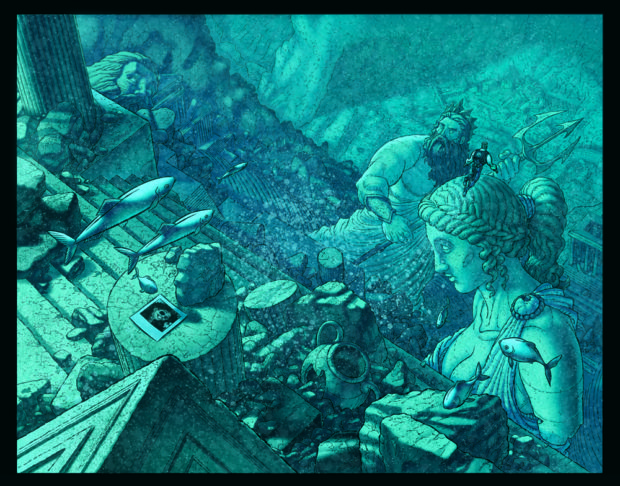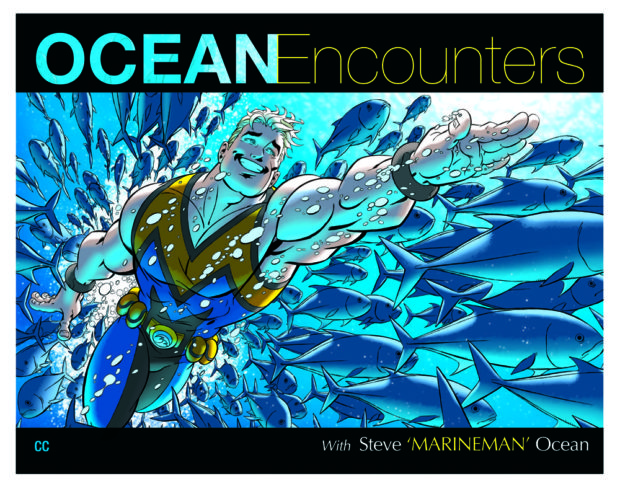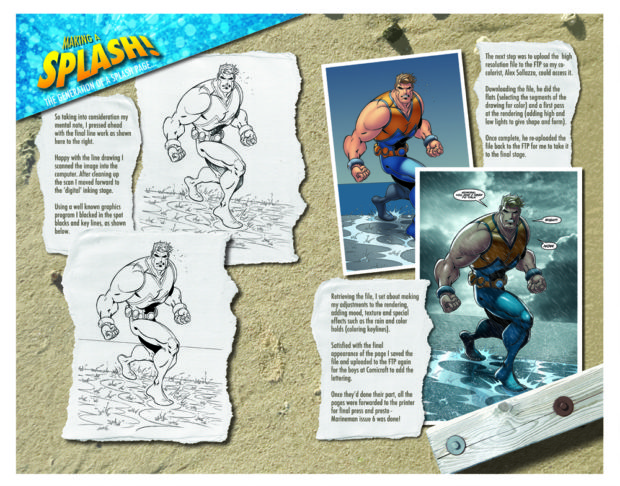Drawn to Diving
Diver Ian Churchill puts his artistic talents to the test with MARINEMAN, a new superhero whose underwater exploits showcase diving and the ocean environment. Can Dr. Steve Ocean save our seas and attract more people into the sport? Read on, the adventure’s just begun!
Text by Michael Menduno
Images/Artwork/Photographs © and ™ Ian Churchill – www.ianchurchillsmarineman.com

At age eight, with Dad’s encouragement, avid comic book reader and Cousteau fan Ian Churchill, created and drew a superhero he called MARINEMAN™, who could see and breathe underwater.

Now, more than 30 years later, the intrepid, 42-year old British comic book illustrator and diver is hoping that his creator-owned comic MARINEMAN, which he launched last December, will inspire readers to get their feet wet. “I want to bring the wonder and amazement of being underwater into comics,” explains Churchill, who says he still gets a thrill doing underwater barrels. “It’s about increasing awareness to a new audience.”
This is not your father’s Aquaman!

Enter larger-than-life diver, marine biologist, activist and TV host Dr. Steve Ocean, aka MARINEMAN, who, like his creator, believes in the power of communicating information through entertainment. In issue #1 we catch up with Ocean in his day job. He’s demonstrating tonic immobility with a lemon shark to kids at Ocean Point Aquarium and Institute of Marine Research. Later he’s televising a great white shark tagging operation on location.

But little does Ocean suspect that his secret powers, to wit: retractable webbed-fingers and the ability to breathe underwater independent of depth or decompression constraints, will soon be accidentally revealed to the public. Steve’s unique abilities had been the well-kept secret of a select cadre of U.S. Navy insiders, including his adopted father and ex-commander Professor David Ocean. This turn of events forces a showdown between Steve’s MARINEMAN persona and a diabolical deep-diving villain intent on wreaking havoc on the undersea world. But I digress.

To be sure, MARINEMAN will whet readers’ appetites for the life hyperbaric with its compelling narrative and bold, breathtaking seascapes replete with wildlife, divers, rebreathers and submersibles. But there’s more. Each issue features an interview with a real-life marine scientist who shares their underwater passions and concerns in ‘The OCEANAUTS’ section. Issue #1 also includes Churchill’s original MARINEMAN sketches.
These are likely a few of the reasons that Churchill’s creation was nominated this April for the prestigious Will Eisner Award – the comic industry’s equivalent of an OSCAR® – in the Best New Series, 2010, category. MARINEMAN is making a splash!

Churchill got his start in comics in 1994, after leaving a career in graphic design. The change was abrupt. At a London comic convention he’d showed his sketches to Marvel’s then editor-in-chief Bob Harras who was so impressed by the work that he hired him on the spot. Over the next decade and a half, the West Sussex-based artist went on to illustrate iconic comics like THE AVENGERS, X-MEN, SUPERMAN, SUPERGIRL, and THE HULK and others, working for both Marvel Comics and DC Comics, which together dominate the industry.
In 2002, Churchill fulfilled another childhood dream when he learned to dive during a trip to Kenya. “I’ve been diving ever since and loving it,” he gleams. ”I can’t do without it.”
Churchill’s childhood creation resurfaced a few years ago, when a shoulder injury forced him to switch drawing styles and re-evaluate his priorities. “I had been thinking about MARINEMAN for 15-years,” Churchill recalled. “It had been building up inside me. I had to get it out or it would have driven me crazy. It was the first thing I thought about when I woke up, and last thing when I went to bed.”
So he took the plunge. Now instead of pencilling corporate comics and having his weekends off, he’s working 72-hour weeks funding, producing, writing, illustrating, inking, and colouring his brainchild, as well as updating his website and promoting the enterprise. He has produced six issues of his all-ages comic to date, which are being published in graphic paperback form, along with lots of bonus material, for the July Comic-Con 2011 convention in San Diego, where the Eisner Award winners will be announced.
Churchill is already imagineering the next series, that is, assuming he and MARINEMAN can inspire enough readers to plunk down a few clams. By my read, the underwater adventurer will be swimming with the fishes for a long time to come.
Ask for MARINEMAN, published by Image Comics, at your local comic shop or buy it online ($3.99 each/back issues available) and visit him at: www.ianchurchillsMARINEMAN.com


Show and Tell
As the graphics tablet inexorably replaces the pencil and computers power the production process, artist Ian Churchill discusses the craft of creating comics.

The industry has changed dramatically since I began working professionally in comics in the early 1990s. In their heyday top-selling titles sold in the millions: today, selling 200,000 is considered a real achievement. Back then, virtually everything was drawn, inked, coloured and lettered by hand. Nowadays, most ‘pencillers’ still use pencil and paper, but many are switching to graphics tablets and a computer powered production process.
When I worked on Marvel or DC titles, I’d be sent a plot outlining what all the characters said and did panel-by-panel, page-by-page – it was a detailed drawing guide. But it was my job to ensure the story flowed through the art. To achieve this I’d draw the image lightly on A3 art board before fleshing out the final drawing in stronger lines. I could be loose with the pencils because, traditionally, I’d have an ‘inker’ to tidy things up, vary the line weights to create the illusion of depth on the page, and to add their own touch. Inkers used to be called ‘embellishers’ because they embellished the artwork.

Next, the page would be coloured; originally by hand, increasingly now it’s a digital process. Sometimes I’d get to make suggestions for the colouring but generally my job was done once the page was drawn and sent off. That’s the traditional comic book ‘conveyor belt’ method, each person doing their part expeditiously so the comic comes out monthly.
Comic books are distributed globally through a company called Diamond Distributors. Every month its catalogue – Previews – details all the titles to be published in the weeks and months ahead allowing retailers to order the stock needed to fill customer requests and to present whatever else they think will sell.
Liberating Challenge
MARINEMAN is creator-owned, which means I hold all the rights to the property along with the responsibility for getting everything to the publisher, Image Comics, on time. It’s been a huge challenge for me and a much different way of working than I’ve been used to, but I’ve had the story in my head for years and finally getting it out on paper has been immensely liberating!
I can’t describe the excitement and apprehension I felt when MARINEMAN issue one arrived at my door. Finally it was in print, in glorious Technicolour, something I could hold, read and flick through! I was so nervous I had Sacha, my wife, open the box for the first look. However good something looks on screen, there’s always the chance the printing might be too light, too dark, too yellow, too blue… Over the years I’d been disappointed by the final print of too many jobs I’d slaved over, and I didn’t know what I’d do if this had been another of those letdowns. Fortunately, it wasn’t.
With MARINEMAN I’m doing it all. On a page or two of A4 paper I sketch out an entire issue in thumbnails, often complete with speech bubbles, which I use as the blueprint for each preliminary page sketch. For this I use blue pencil, later drawing over the final art in black pencil. The blue allows me to be messy. Once scanned into my computer I can hit a couple of ‘sliders’ and the blue vanishes leaving just the final line work. Because the scans pick up every detail, further clean up is required and in some cases I’ll manipulate the images on the screen so the page is laid out to my satisfaction.
Inking comes next. This is blacking in all the heavy blacks and adjusting the levels of the line work on screen so it looks like it’s been manually inked. This could be done on the board but there’s less margin for error with a computer. The high-resolution file is then sent to my colourist, Alex Sollazzo, who does the ‘flatting’ or colouring of each segment of the line work, a preparatory step to rendering – adding highlights and lowlights that give shape and form to the illustration. I’d hoped to do all the colouring myself, but after completing the first half of issue one I realized I’d need help to maintain the schedule. Still, this is a very personal project so I do all the final rendering of special effects, shading, backgrounds, etc., that bring the final look of MARINEMAN and his world in line with my vision.
Meantime, I’ve written the script and sent it off with the inked pages to the letterer, my good friend Richard Starkings, at his company Comicraft. Richard pioneered the use of digital lettering in the early 1990s, before which lettering was done by hand. Once all the speech bubbles and any additional lettering are in place, I’m sent a PDF of the draft issue. Now I finalize the text, tweak dialogue, make sure all spelling and punctuation are correct and the speech bubbles are in the best position to complement the art. Comicraft makes the necessary changes. I get a final draft to double and triple check everything before it goes to the printer. At this stage I’m generally too tired to see straight so my wife steps in with a fresh pair of eyes to spot errors the rest of us may have missed.
Labour of Love
MARINEMAN was an idea that wouldn’t go away, something I wanted to do for a very long time for several reasons. Getting the story out of my head and onto the page isn’t about making my fortune. It’s about widening the appeal of comics for anyone who loves a rollicking good adventure and to create something fun (that I would have appreciated as a kid) to combat all the ‘grim and gritty’ found in comics and life these days. In achieving this, of course, it was equally important to me to raise awareness of the ocean environment that informs life on Earth. I wanted to use the vehicle of MARINEMANE to convey the beauty, the wonder, and the fragile nature of this liquid realm in an entertaining way.
I think a key element of creating a believable story is to set it in places that look and feel realistic. The original stimulus for the design of Ocean Point Aquarium came from the visitor centre at the National Trust’s Fountains Abbey in Yorkshire. My wife and I were on our way home from Scotland when we stopped to visit this truly beautiful place. The building’s wooden wave-shaped overhang inspired me to create Ocean Point as a nautilus-shaped structure.
An aspect of the project I’ve really enjoyed is returning to my professional roots in concept and logo design, as well as page layout. Originally, the logo I designed for Ocean Point Institute for Marine Research was a stingray, but it wasn’t versatile enough – for example it also serves as MARINEMAN’s belt buckle – so it became a wave instead. As things have evolved, this logo has become almost as integral as the name MARINEMAN itself.
Comic Fans Needed
The record shows that underwater characters attract many loyal fans but they don’t sell as well as land-based characters. And it’s noteworthy that MARINEMAN, unlike virtually every other underwater superhero, isn’t Atlantean royalty. I think it’s that much harder to relate to a character who doesn’t live in our terrestrial world and who, in his watery realm, also happens to be a prince residing in a mythical sunken city. I’ve tried to make MARINEMAN more believable so readers can identify with him. Hence, Steve Ocean is a regular guy with a regular life that includes friends and a job when he’s not his alter ego.
But when he is in super hero mode, his achievements are better appreciated if readers know something of his extraordinary abilities, which isn’t the case with other underwater comic characters. MARINEMAN’s super powers are extensions of what actual marine creatures can do, which should inspire a sense of wonder in us all. MARINEMAN can breathe underwater. He secretes a lubricant through his skin that reduces friction and allows him to glide through the water faster. He looks big and muscular, but much of that is whale-like blubber, which protects him from the cold even at extreme depths. Of course, the ability to withstand the intense pressure of these depths makes him exceptionally strong. Like dolphins he can echolocate, like some other animals he has nictitating membranes that facilitate underwater vision, and his fingers are webbed.
And if, fellow comic fans, we’ve become a tad complacent today in the face of so many super heroes and all the fantastical powers they wield, then we need to pause for an ‘un- reality check’. I mean really if a normal human exhibited such super powers it would be mind-blowing. As a kid the super powers I most wanted were the ability to breathe underwater or to fly. I was a member of the British Sub Aqua Club at the age of eight and I jumped through hoops to prove I was competent using an aqualung but they thought I was too young and there was nothing more I could do, so I left. But imagination can do wonders…
There have been movies and TV shows based around comic characters for as long as I can remember. Lately, we’re amidst a revival, it seems, and I hope this big screen attention encourages more people to pick up comic books and enjoy the story and artwork. Though I haven’t been to the cinema recently I do watch trailers online. I like that some of the lesser-known (in a mass market sense) characters are getting some screen time, and it’s great that these movies appeal to comic fans and non-believers alike. Fans appreciate the occasional nod to comic book insider jokes like the one about Wolverine’s costume in the first X-Men movie – would you prefer yellow spandex? I think these movies have managed to distill the essence of the characters and storyline from the comics, and appeal to a wider audience.
I’m bummed that I haven’t seen Thor on the big screen yet, he was always a favourite character of mine and Norse mythology has always been a hobbyhorse for me. The trailer looks amazing. I’m also looking forward to X-Men First Class (I love the idea of a prequel, especially with a cameo by Hugh Jackman’s Wolverine), Green Lantern, and especially Captain America, who’s been a favourite superhero since I was a kid. Iron Man and Iron Man 2 were both fantastic and expertly realized, but my all-time favourite superhero movie is still Richard Donner’s Superman The Movie. Christopher Reeve just was Superman. The scene in which he transforms from geeky Clark Kent to Superman with a subtle change of posture and expression was stunning; a truly skillful piece of acting that convinces you a hat and glasses actually could disguise his secret identity.
My dream come true has been to see MARINEMAN in print; to see him on the big or small screen would be icing on the cake. It’s early days still and reaction from fans and reviewers has been very positive. Sales have been better than I imagined considering it’s an all-ages comic book about an underwater character that has had to combat the economic downturn alongside everyone else. And it’s a different dynamic today. Comics aren’t for sale in the corner store as they once were and kids don’t go into comic specialty shops much so my hope is that guys who were in to comic books when they were young, and who now have their own children, will want to share their passion for comics and read MARINEMAN with and for their kids. As with diving, the comic book industry must attract a new, younger generation if it is to continue and thrive.







